七年级英语上册Module5MySchoolDayUnit3Languageinuse教案(新版)外研版
- 格式:doc
- 大小:53.00 KB
- 文档页数:6
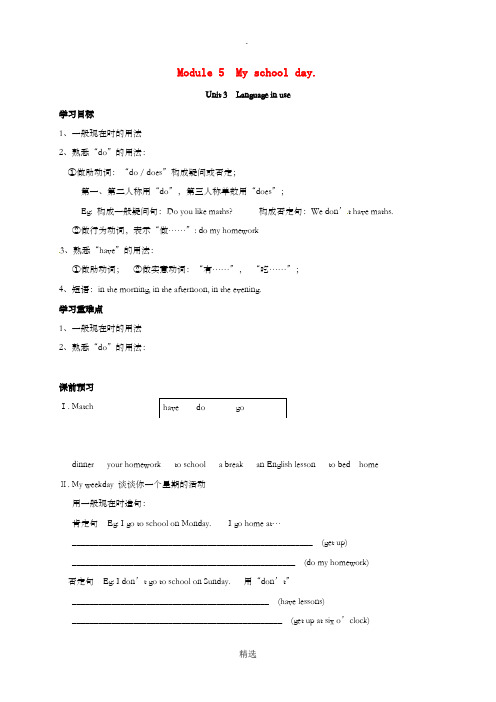
Module 5 My school day.Unit 3 Language in use学习目标1、一般现在时的用法2、熟悉“do”的用法:①做助动词:“do / does”构成疑问或否定;第一、第二人称用“do”,第三人称单数用“does”;Eg: 构成一般疑问句:Do you like maths? 构成否定句:We don’t have maths.②做行为动词,表示“做……”: do my homework3、熟悉“have”的用法:①做助动词;②做实意动词:“有……”,“吃……”;4、短语:in the morning, in the afternoon, in the evening.学习重难点1、一般现在时的用法2、熟悉“do”的用法:课前预习Ⅰ. Matchhave do godinner your homework to school a break an English lesson to bed home Ⅱ. My weekday 谈谈你一个星期的活动用一般现在时造句:肯定句Eg: I go to school on Monday. I go home at…_______________________________________________________ (get up)___________________________________________________ (do my homework)否定句Eg: I don’t go to school on Sunday. 用“don’t”_____________________________________________ (have lessons)________________________________________________ (get up at six o’clock)●课堂学习研讨Ⅰ. Share your activities 分享你一周的活动1. I get up at…2. I go to school at …3. I don’t go to school on Sunday…Ⅱ. Finish exercise 2, exercise 3, exercise 4 and exercise 5. 完成练习(P30:2—5)Ⅲ. Around the worldThe school day in the UK (英国的学校日)What is your school d ay like in China. 你在中国的学校日是怎么样的呢?Ⅳ. Talk about your ideal sc hool day. 谈谈你理想中的学校一天的活动Activities Timeget upgo to schoolhave a break......● 课后巩固练习Ⅰ. 单项选择( ) 1. Maths _______ a useful subject. A. am B. is C. are D. be( ) 2. We _______ to bed at ten o’clock. A. go B. to go C. goes D. going ( ) 3. Tom has three classes _______the morning and has a break ________ half past seven.A. in; inB. in; atC. on; atD. at;in( ) 4. My mother ________ have lunch at home because she is at work in her office.A. don’tB. doesn’tC. isn’tD. hasn’t( ) 5. —When does your mother go shopping? —Usually _______ Sunday morning.A. onB. inC. atD. for( ) 6. Betty likes _______ very much. She draws pictures every day.A. artB. mu sicC. sportD. science( ) 7. I usually do some reading ______ 6:00 pm ______ 8:00 pm.A. at; toB. at; atC. between; toD. from; to( ) 8. I’m tired. Let’s _______.A. have a breakB. runC. go to schoolD. play basketball( ) 9. —_______ is the talk show? —It’s in the morning.A. WhereB. WhenC. What timeD. How( ) 10. It’s time _______ school. A. to B. at C. for D. inⅡ. 句型转换1. We have lunch at half past twelve. (改为否定句)We ________ _________ lunch at half past twelve.2. In the morning, we have a break. We talk to our fri ends. (用and连接两个句子)In the morning, we have a break _______ ________ ________ _________ ________.3. I play football at 4:30 every Saturday. (改为一般疑问句)_______ you _______ football a t 4:30?4. We have Chinese lessons at 8:30. (对划线部分提问)_______ ________ do you have Chinese lessons?5. Mary and Max always go to bed at 9:00. (对划线部分提问)_______ _______ Mary and Max always do at 9:00?如有侵权请联系告知删除,感谢你们的配合!。
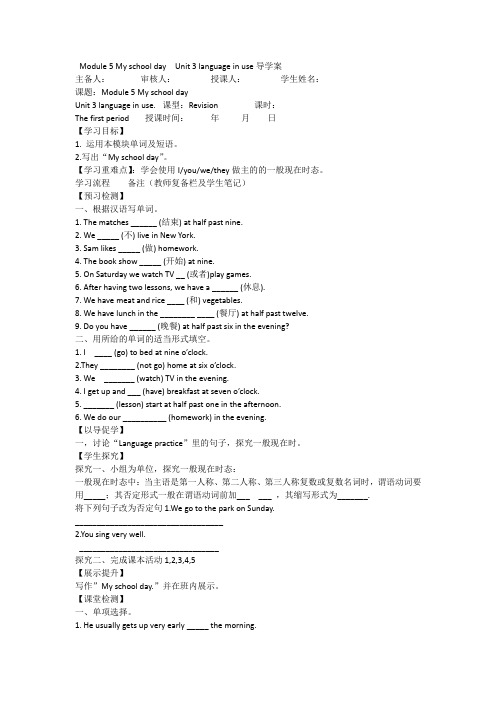
Module 5 My school day Unit 3 language in use导学案主备人:审核人:授课人:学生姓名:课题:Module 5 My school dayUnit 3 language in use. 课型:Revision 课时:The first period 授课时间:年月日【学习目标】1. 运用本模块单词及短语。
2.写出“My school day”。
【学习重难点】:学会使用I/you/we/they做主的的一般现在时态。
学习流程备注(教师复备栏及学生笔记)【预习检测】一、根据汉语写单词。
1. The matches ______ (结束) at half past nine.2. We _____ (不) live in New York.3. Sam likes _____ (做) homework.4. The book show _____ (开始) at nine.5. On Saturday we watch TV __ (或者)play games.6. After having two lessons, we have a ______ (休息).7. We have meat and rice ____ (和) vegetables.8. We have lunch in the ________ ____ (餐厅) at half past twelve.9. Do you have ______ (晚餐) at half past six in the evening?二、用所给的单词的适当形式填空。
1. I ____ (go) to bed at nine o’clock.2.They ________ (not go) home at six o’clock.3. We _______ (watch) TV in the evening.4. I get up and ___ (have) breakfast at seven o’clock.5. _______ (lesson) start at half past one in the afternoon.6. We do our __________ (homework) in the evening.【以导促学】一,讨论“Language practice”里的句子,探究一般现在时。
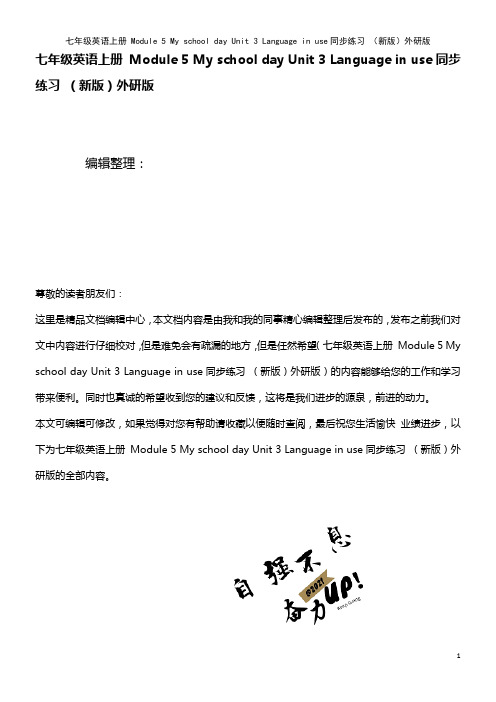
七年级英语上册Module 5 My school day Unit 3 Language in use同步练习(新版)外研版编辑整理:尊敬的读者朋友们:这里是精品文档编辑中心,本文档内容是由我和我的同事精心编辑整理后发布的,发布之前我们对文中内容进行仔细校对,但是难免会有疏漏的地方,但是任然希望(七年级英语上册Module 5 My school day Unit 3 Language in use同步练习(新版)外研版)的内容能够给您的工作和学习带来便利。
同时也真诚的希望收到您的建议和反馈,这将是我们进步的源泉,前进的动力。
本文可编辑可修改,如果觉得对您有帮助请收藏以便随时查阅,最后祝您生活愉快业绩进步,以下为七年级英语上册Module 5 My school day Unit 3 Language in use同步练习(新版)外研版的全部内容。
Module 5 My school day Unit 3 Language in useⅠ.请用介词at、on、in完成下列短语.1.______ the mor ning2.______Sunday3.______ seven o’clock4.______ Wednesday morning5.______ the afternoon6.______ half past sixⅡ.单项选择。
1.Chang’e Ⅱ was launched(发射)______ the afternoon of October 1st,2010. A.in B.from C.on D.at2.Lucy likes music ______ she has guitar lessons on Saturday.A.but B.and C.or D.of3.Tony's grandmother often ______ breakfast at 7:00 in the morning.A.finis h cooking B.finishes cooking C.finishes cook D.finish cook 4.We______ science today.A.not have B.has not C.don’t have D.not5.I really want to have a______。
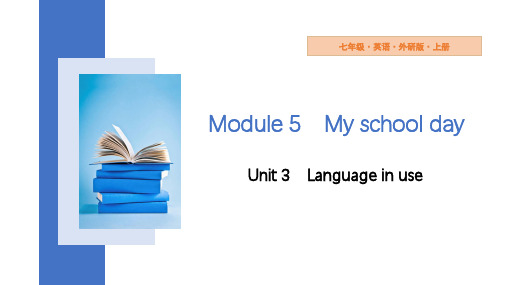
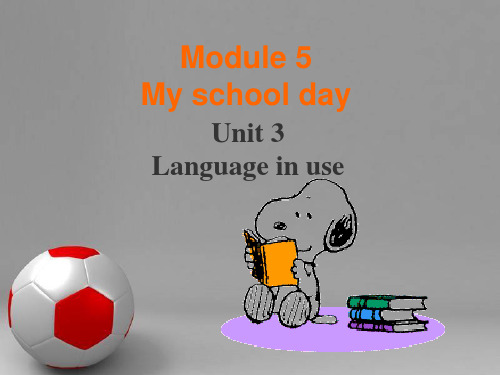
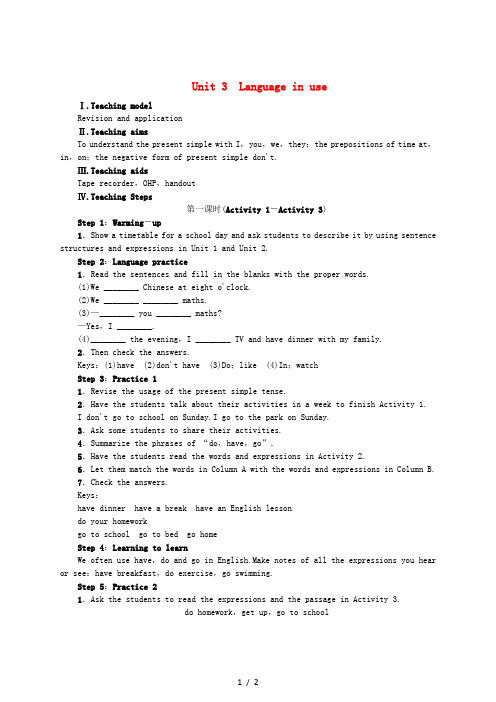
Unit 3 Language in useⅠ.Teaching modelRevision and applicationⅡ.Teaching aimsTo understand the present simple with I,you,we,they;the prepositions of time at,in,on;the negative form of present simple don't.Ⅲ.Teaching aidsTape recorder,OHP,handoutⅣ.Te aching Steps第一课时(Activity 1-Activity 3)Step 1:Warming-up1.Show a timetable for a school day and ask students to describe it by using sentence structures and expressions in Unit 1 and Unit 2.Step 2:Language practice1.Read the sentences and fill in the blanks with the proper words.(1)We ________ Chinese at eight o'clock.(2)We ________ ________ maths.(3)—________ you ________ maths?—Yes,I ________.(4)________ the evening,I ________ TV and have dinner with my family.2.Then check the answers.Keys:(1)have (2)don't have (3)Do;like (4)In;watchStep 3:Practice 11.Revise the usage of the present simple tense.2.Have the students talk about their activities in a week to finish Activity 1.I don't go to school on Sunday.I go to the park on Sunday.3.Ask some students to share their activities.4.Summarize the phrases of “do,have,go”.5.Have the students read the words and expressions in Activity 2.6.Let them match the words in Column A with the words and expressions in Column B.7.Check the answers.Keys:have dinner have a break have an English lessondo your homeworkgo to school go to bed go homeStep 4:Learning to learnWe often use have,do and go in English.Make notes of all the expressions you hear or see:have breakfast,do exercise,go swimming.Step 5:Practice 21.Ask the students to read the expressions and the passage in Activity 3.do homework,get up,go to schoolhave a break,have breakfasthave lunch,start workOn Friday I have a busy day.I (1)________ at half past six in the morning.Then I wash my hands and face,and (2)________ at seven.At half past seven,I (3)________,and(4)________ at eight.There are four lessons in the morning.At twenty to ten,we(5)________ for twenty minutes.We go to the playground and I talk with my friends.We(6)________ in the school dining hall.In the afternoon,we have two lessons and go home at half past three.I don't (7) ________ on Friday evening.I do it on Saturday.2.plete the passage with the expressions from the box.3.Call back the answers from the whole class,check the answers.Keys:(1)get up (2)have breakfast (3)go to school (4)start work (5)have a break (6)have lunch (7)do homework4.Ask the students to read the passage aloud.Step 6:Homework1.Revise all the key points in this module.2.Finish the workbook.Blackboard DesignUnit 3 Language in use (Activity 1-Activity 3)(1)get up (2)have breakfast (3)go to school(4)start work (5)have a break(6)have lunch (7)do homework(本资料素材和资料部分来自网络,供参考。
天津市静海县沿庄镇2017-2018学年度七年级英语上册Module 5 My school day Unit 3 Language in use教案(新版)外研版
编辑整理:
尊敬的读者朋友们:
这里是精品文档编辑中心,本文档内容是由我和我的同事精心编辑整理后发布的,发布之前我们对文中内容进行仔细校对,但是难免会有疏漏的地方,但是任然希望(天津市静海县沿庄镇2017-2018学年度七年级英语上册Module 5 My school day Unit 3 Language in use教案(新版)外研版)的内容能够给您的工作和学习带来便利。
同时也真诚的希望收到您的建议和反馈,这将是我们进步的源泉,前进的动力。
本文可编辑可修改,如果觉得对您有帮助请收藏以便随时查阅,最后祝您生活愉快业绩进步,以下为天津市静海县沿庄镇2017-2018学年度七年级英语上册Module 5 My school day Unit 3 Language in use教案(新版)外研版的全部内容。
Unit3 Language in use。
Module5Unit3 Language in use.课型:Revision课时:45 minutes课前预测:They have learnt how to introduce their school life in English, In this Unit, It will be easy to consolidate them.教学方法:Interactive approach板书设计:Key words and sentences about school life in PPT.教学目标:1. Master the key words and expressions in Module 5.2.Learn to use the key sentences to introduce their school life.3.Cultivate their ability of creation.教学重难点:1.Key words and expressions:All the new words and expressions in Module 5.2.How to introduce their school life or weekend in English.教学准备:PPT/pictures on the Internet/ videotape.教学过程:Step 1.Warming up:1.Revise Unit 2 by showing a table about time to revise:My friend get up at..., I get up at...2.New words and expressions.nguage practiceRead the sentences in the language practice, have a small inclusion.Step3.Match the words.1.Match the words in Part 2, check answers.2.Read the answers.plete the passage.plete the passage in Part 3 on their own, check answers.2.Read the passage together.Step5. Complete the sentences with preps.1.Show a table about the preps and tell them how to use them.2.Finish Part4 by themselves.3.Check answers and read them together.4.Finish Part 5 and read it together.Step6.Around the world.Read the passage to learn about some western cultures.Step 7. Module task.plete the table with the information about your ideal school day.2.Work in pairs to talk about your ideal school day.nguage points .Step 9.Words and expressions in Module 5.Step9.ExercisesDo some exercises in class to consolidate what they have learnt in this lesson. Encouragement should be given.Step10. Homework1.Write a passage to introduce your school day.2.Exchange your passage with your friends, retell his or her passage with he/she.3.Read the key sentences skilly.4.Additional exercises.。
Unit 3 Language in use Teaching aimsTo summarize and consolidate Present simple with I, you , we , they prepositions of time at, in , on negative form of present simple don't.Teaching ObjectivesKey vocabulary: finish, houseworkKey structures: Present simple with I, you , we , they prepositions of time at, in , on negative form of present simple don't.Teaching StepsStepl.行为动词的一般现在时表达经常性或者习惯性的动作,就要使用一般现在时。
.I do my homework in the evening.我在晚上做作业。
如果表示的是现在的状态,也可以用一般现在时。
.I know him very well.我和他很熟。
肯定句中的行为动词一般现在时。
.I play basketball in the playground.You draw very well.We like the blue chairs in the classroom.They work in America.Chen Xi and Chen Li eat breakfast at home.一般现在时肯定句结构为“主语+谓语动词原形+其他”。
否定句中的行为动词一般现在时。
.1 don't play basketball in the playground.You don5t draw very well.We don't like the blue chairs in the classroom.They don't work in America.Chen Xi and Chen Li don't eat breakfast at home.一般现在时否定句结构为“主语++谓语动词原形+其他”。
Module 5 My School Day一、教学目标1. 重点单词:half, past, o’clock, to, art, geography, history, IT, maths, (Am E math ), PE ( physical education ), lesson, then, like, difficult, love, subject, because, interesting, talk, begin, when, weekday, house, start, work, break, evening, watch, do, homework, bed, sleep, park, busy, wash, face, minute2. 重点短语:go to school, get up, have breakfast, have lunch, go home, have dinner, go to bed, go to sleep3.重点句子:1) I love history.2) It’s twelve o’clock .3) We have Chines e at eight o’clock.4) We don’t have maths.5) —Do you like maths?—Yes, I do.6) In the evening, I watch TV and have dinner with my family.7) I get up at half past seven in the morning and have breakfast.8) I drink Cola or water.9) We start work at n ine o’clock.二、重点及难点:1.时间的表达方式。
2.用在时间前的介词(at , in , on)的用法。
3.一般现在时的陈述句形式(主语为I, they, we, you)。
4.And 连接的两个简单句。
三、教学设计:Unit 3 Language in useⅠTeaching modelRevision and applicationⅡTeaching methodFormal and interactive practiceⅢTeaching aimsTo summarize and consolidate Present simple with I , you , we , they prepositions of time at , in , on negative form of present simple don’t .ⅣTeaching ObjectivesKey vocabulary: finish, houseworkKey structures : Present simple with I , you , we , they prepositions of time at , in , on negative form of present simple don’t .ⅤTeaching aidsTape recorder , OHP , handoutsⅥTeaching StepsStep 1 RevisionReview the text of Unit 1 and Unit 2 .Step 2 Language practice1. Read through the example sentences in the box with the whole class.2. Ask the students to repeat the sentences in the box.3. Grammar : The present simpleStep 3 Work in pairsAsk the students to talk about their activities in a week.Match the words in Column A with the words and expressions in Column B.1. Read through the phrases with the whole class.2. Ask the students to match the words in Column A with the words and expressions in Column B with a partner .3. Call back the answers from the whole class, check the answers.Keys :1. have: a, d, e2. do: b3. go: c, f, gMake phrases with do, have or go.1. Ask the students to fill in the blank individually , then check with a partner .2. Call back the answers from the whole class, check the answers .Keys :1.have2. do3. go4. have5. have6. do7. go8. go3. Read the phrases with the whole class.Step 4 Complete the passage.1. Read through the passage with the whole class.2. Ask the students to Complete the passage with the expressions from the box witha partner.3. Call back the answers from the whole class, check the answers.Keys :1. get up2. have breakfast3. go to school4. start work5. have a break6. have lunch7. do homeworkStep 5 Complete the sentences with at, in or on.1. Review the using of at, in and on.2. Ask the students to fill in the blank individually , then check with a partner .3. Call back the answers from the whole class , check the answers .Keys :1. in2. on3. at4. on5. in6. atStep 6 Complete the sentences with the words from the box.1. Read through the phrases with the whole class.2. Ask the students to complete the sentences with the words from the box with a partner.3. Call back the answers from the whole class, check the answers.Keys :1. break2. subject3. because4. interesting5. homeworkStep 7 Important and difficult points.1.时间的表达方式。
1) 直接表示时间法:就是按照几点几分的顺序来表示时间。
(这个最简单)例如:8:00——eight o’clock 5:20——five twenty2) 添加介词表示法:如果分数小于或等于30,就用past来表示,结构是“分钟+past+该点钟“;如果分钟大于30,就用to来表示,结构是“分钟+to+下一点钟例如: 12:05——five past twelve9:50——ten to ten8:40——twenty to nine如果分钟是15,一般用a quarter 来代替fifteen; 如果分钟是30,一般用half来代替thirty。
例如:9:15——a quarter past nine11:30——half past eleven2:45——a quarter to three2.用在时间前的介词(at , in , on)的用法。
at常用来表示在某点时间,即“在几点几分;在某一时刻”。
如:She usually gets up at 6:00 in the morning.她通常早上6点起床。
The man often gets to his office at 8:30.这个男人经常8:30到他的办公室。
另外,at还可以用在at night(在晚上),at last(最后),at weekends(在周末)at noon(在中午)等固定短语中。
on常用来表示“在某天或星期几”。
另外,表示“在某天的上、下午或晚上”时,介词也用on。
如on Sunday(在星期天),on weekends(在周末), on February 8th(在二月八日), on Monday morning(在星期一上午), on the afternoon of November 21st(在十一月二十一日下午) on a cold winter evening(在一个寒冷冬天的夜晚)in表示“在某一段时间”,如某年、某月、某个季节,如:in 1998(在1998年)in March(在三月),in summer(在夏天)。
另外,在某一些固定短语中要用in,如in the morning, in the evening,in the day ,in the middle of the day 。
Step 8 Around the world:1. Ask the students to look at the picture and discuss what they can see .2. Read through the information with the whole class, and talk something about them. Step 9 Module task: Talking about your ideal school day.1. Complete the table with information about your ideal school day.2. Look through Module 5 and find expressions to say what you do and enjoy every day.Step 10 ExerciseA、用英语写出下列时间6:00 ______________ 5:30___________\____________8:10 ___________\____________ 7:20 ___________\____________9:50 ___________\____________ 10:40 ___________\____________4:15 ___________\____________ 3:45 ___________\_____________Answers :6:00 six o’clock , 5:30 five thirty / half past five8:10 eight ten / ten past eight , 7:20 seven twenty / twenty past seven 9:50 nine fifty / ten to ten , 10:40 ten forty / twenty to eleven4:15 four fifteen / a quarter past four , 3:45 three forty-five / a quarter to four B.汉译英:1. 在七点钟______________2. 在上午___________________3. 在星期天______________4. 在星期一的上午____________5. 吃晚饭________________6. 课间休息______________________7. 上床睡觉____________ 8. 做家庭作业________________9. 上英语课______________ 10. 回家_____________________11. 上学_______________ 12. 干家务活_________________Answers :1. at seven o’clock2. in the morning3. on Sunday4. on Monday morning / on the morning of Monday5. have supper6. have a break7. go to bed8. do one’s homework 9. have an English lesson 10. go home 11. go to school12. do houseworkC. 根据短文内容及首字母提示,在空格处填入正确的词,使短文意思完整。